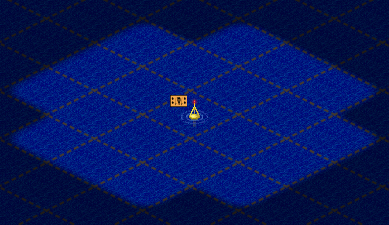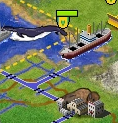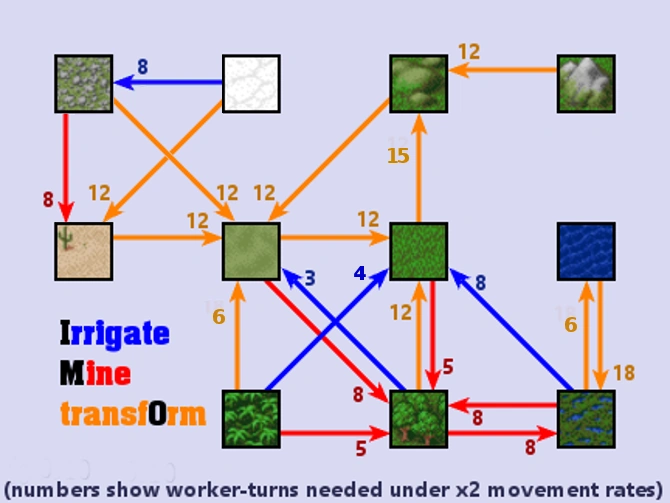| Multiplayer II Manual |
|---|
 |
Quick Jumps:[]
World[]
The Freeciv world map is made of tiles (squares). Each is some type of terrain. The eastern and western edges connect, forming a cylinder that can be circumnavigated.
Terrain[]

WRAPX "cylindrical" map
Terrain tiles affect 3 distinct game elements: (1) Unit combat, (2) Unit movement, (3) Resources for cities. Each is discussed below:
Unit Combat[]
Terrain affects combat. When a land unit is attacked, its defense strength is multiplied by the bonus of the terrain. See the page on combat for details, and the Terrain chart below for which terrains offer bonuses. (Rivers give an extra bonus of +33%.)

Road
Unit Movement[]
Sea and air units always use one movement point to move one tile. Terrain only influences the movement speed of land units.
Land units - movement "speed":
- Moving across easy terrain costs one point per tile; moving onto rough terrain costs more. The move cost for different terrain is given in the Terrain chart below.
- Explorers, Partisans, and Alpine Troops travel light. Moving one tile costs only ⅓ of a movement point. (They can use railroads like anyone else.)
- Other land units spend ⅓ of a movement point per tile along rivers and roads, as long as the tile they are leaving has connected a river or road.
- With Railroad technology, roads can be upgraded to railroads. Units can move 3x faster than on roads, or 9x faster than unimproved terrain, if using a railroad. Beware that roads and railroads can help an enemy army as much as your own. If Restrictinfra is ON, as it is by default, enemy units on rails can only use them at 3x speed, the same as a normal road.
- With Superconductors technology, you may build MagLevs (Magnetic Levitation rails). MagLevs allow units to travel with unlimited movement points.
Cities always have roads inside — and bridges and railroads if the nation has those technologies.
With the Bridge building advance, roads and railroads can be built on river tiles to bridge over them.
Resources for Cities[]
Tiles within range of a city may be worked by that city. Cities may be built on any terrain except Ocean or Arctic.
When a city works a tile, it receives three products: food, production, and trade. Output of a tile is conventionally written as food/production/trade. For example, "1/2/3" is a tile that produces 1 food, 2 production, and 3 trade.
Terrain sometimes has a special resource which boosts food, production, or trade. Terrain transformation can make resources inaccessible; for instance, if a Forest with a pheasant is transformed to Plains, it will lose its food bonus. Changing Arctic Oil to Desert Oil still preserves Oil because the resource is valid on both terrain types.
The Terrain chart below lists the output of each terrain, both with and without special resources.

Irrigation

Farmland

Mine

Quay
Improving Terrain[]
Mining, roading, and irrigating can be done by Workers, Settlers, Engineers, and Proletarians to improve terrain. Transforming is an action that only Engineers can perform.
Workers, Settlers, Engineers, and Proletarians can "irrigate" to produce more food, cut a forest, drain a swamp; or "mine" to yield more production points, plant a forest, or create a swamp.
Irrigation and Mines can't co-exist on the same tile. Once built, a mine or irrigation system will replace the other.
A Mine can be put on Hills, Mountains, or Desert. Mining desert makes an Oil Well--it requires Construction technology. The Terrain Chart below shows the increased production yield.
To irrigate land, the player must have a water source in one of the four cardinally adjacent tiles. Water sources are oceans, lakes, rivers, or any other irrigated land except a city tile.
Terrain can be transformed into a new type. Attempting to irrigate a forest, for example, creates plains. (See "Terrain Modification Flowchart" below.) Note that you cannot plant a forest or "grow a hill" under an existing city's tile.
Roads, Railroads, and MagLevs can be built on the same tile as other improvements (such as irrigation). Note that roads and rivers enhance trade for some types of terrain, and railroads increase the production output of a tile by 50%. MagLevs provide no benefit other than unlimited movement.
A Quay is a river improvement that facilitates off-loading traffic from river transports, facilitating connectivity to nearby roads. The quay itself is considered as a road type. Stepping onto a quay tile takes 1 move point. Stepping out behaves the same as a road. Quays require Pottery. Like bridges, quays auto-upgrade your cities when you get the tech.
- Ships can Unload Transport (T) in a quay. Units unloaded this way can use adjacent roads with no unload-penalties.
| Moves Needed to Cross a River | ||
| No bridge or quay | 2.00 | 6/3 |
| Quay adjacent to road | 1.33 | 4/3 |
| Bridge adjacent to road | 0.67 | 2/3 |
Later improvements[]

Hideout

Fort

Fortress

Airbase

Naval Base

Buoy and its vision
There are six military terrain improvements"
- A Hideout can be made in Forests, Swamps, Mountains, and Jungle, but not in someone else’s territory. Units in a hideout are invisible to other players. Only Foot soldiers can make Hideouts. All Land units and Helicopters can hide in them. Other types will be seen. Hideouts are not seen or detected on the map, are invisible to anyone not occupying the tile, and only appear as an activity icon near the unit who is hiding in it. The only way to see a Hideout is to have a unit inside it. Hideouts can't co-exist with other base types. Hideouts utilize natural terrain and foliage; therefore, for each turn it is unoccupied, a Hideout has a 15% chance of being lost to weather or other forces of nature.
- The hideouts setting defaults to enabled, but can be disabled in server settings.
- A Fort represents quick improvised fortifications that increase defence and provide an outpost. Enemies can only kill units one at a time instead of all at once. Against Land and Sea units, defenders will enjoy a 1.33x defence bonus. (The exception is Armor, which is designed to break through such defences.) Whether occupied or not, a Fort provides free vision on every tile around it and 2 tiles out in the cardinal directions. This makes it useful for border watch security. Forts do not claim national territory, but allow a Settler to claim the tile to build a city. The hot-key to make a Fort is shift-F.
- A Fortress can be built on a tile that already has a Fort. Enemies can only kill units in a Fortress one at a time instead of all at once, and defence is doubled against Land and Sea units. Unlike the Fort, the Fortress also provides a 1.66x defence bonus against Helicopters, Armor, and Air units. Fortresses claim and extend national borders. Once Invention is discovered, units in a Fortress have increased vision. The hot-key to make a Fortress is shift-F.
- In an Airbase, units are also killed one by one. Air units become open to attacks by land units. Air units and Helicopters may land and refuel. Paratroopers can be launched from airbases. Airbases can't be made by Settlers. The hot-key to make an Airbase is shift-E.
- Buoys are made by Workers or Engineers on board a ship on Oceanic terrain. Buoys give vision of surrounding tiles. A chain of Buoys can give early warning for sea traffic or amphibious invasions. They can be pillaged by all warships from Ironclad onward. The hot-key to make a Buoy is shift-F. Buoys can see cardinally adjacent Submarines.
- A Naval Base is a Fortress which gives refuge for Sea units to heal with a defense bonus and without the threat of kill-stack or the "Pearl Harbor effect." In straight cardinal directions, they can see Submarines at a distance of 2 tiles. Enemies can only kill units in a one at a time. Requirements are Engineering, Low-land terrain, and a tile cardinally adjacent to ocean.
- In Freeciv, bases have complex rules. Bookmark the page on Bases to reference full details.
- Terrain and Base defense bonuses multiply together. Bookmark this chart for reference.
After Refrigeration has been discovered, irrigated tiles can be irrigated one more time to make Farmland. This increases tile food production by 100% if the city working it has a Supermarket.
Only engineers can directly Transform land (hotkey: "O"). (See Terrain Modification Flowchart below.)
- For transforming Swamp to Ocean, one of the eight adjoining tiles must be ocean already.
- To transform Ocean into Swamp at least 3 of 8 adjacent tiles must be land. To work on Ocean, Engineers must be on a transport. The new Swamp tile will get a river if built adjacent to some river tile's single mouth.
Engineers work at double speed. They complete all improvements in half the turns specified in the Terrain Modification Flowchart and Terrain Chart.
Two or more units working on the same tile under the same orders combine their labor, speeding completion of their project. Be careful: when a unit's working orders are interrupted, its progress is lost.
Any special resource on a tile is lost after its terrain type is transformed. It reappears if the tile can be transformed back to its original terrain.

River
Rivers[]
Rivers increase movement the same as Roads while giving a +33% defense bonus. Roads can't be placed over river tiles until Bridge Building is discovered. A tile with a river gives trade the same as a tile with a road. On Grassland, Plains and Desert, a tile with a bridge will give an extra +1 trade more than a road. On other terrain, bridges give no trade bonus.
Canals[]

Canals are terrain improvements that allow ships to pass. They provide no other bonus. Build-time is 5 worker-turns, the same as a Mine. Unlike rivers, they cannot be used for irrigation, do not give a trade bonus nor bonus movement. You may build Canals with Settlers, Workers, Engineers, or Proletarians after researching Engineering. Canals require a nearby River, Lake, or Ocean to sustain water flow, and can only be built if adjacent. This means canals are usually a maximum length of 1-2 tiles, though they can be longer if they connect through rivers or small lakes. A Canal's water source can be sustained by transforming land tiles to Swamp and then to Lake or Ocean. See Terrain Modification Flowchart, below.
Terrain Chart[]
| Terrain | F/P/T | Special 1 | F/P/T | Special 2 | F/P/T | Move cost • Defence |
Result: Irrigate(turns) |
Result: |
|---|---|---|---|---|---|---|---|---|
| Deep ocean |
1/0/2 | 1M
1× |
✘ ✘ |
✘ ✘ | ||||
| Desert |
0/1/0 | Oasis ‡ |
3/1/0 | Oil |
0/4/0 | 1M 1× |
+1F (3) +1P (3) |
+1T (1) Plains (12) |
| Desert river † |
0/1/1 | +2F (3) |
||||||
| Forest |
1/2/0 | Pheasant |
3/2/0 | Silk |
1/2/3 | 2M
1.33× |
Plains (3) Swamp (8) |
+0T (2) Grassland (12) |
| 1/2/0 | Wild Boar ** |
4/2/0 | ||||||
| Grassland |
2/0/0 | Shield |
2/1/0 | Deer ** |
5/0/0 | 1M 1× |
+1F (3) Forest (5) |
+1T (1) Hills (15) |
| Hills |
1/0/0 | Coal |
1/2/0 | Wine |
1/0/4 | 2M 2× |
+1F (5) +3P (5) |
+0T (2) Plains (12) |
| Jungle |
1/1/0 | Gems |
1/1/5 | Fruit |
5/1/2 | 2M 1.5× |
Grassland (4) Forest (5) |
+0T (2) Plains (6) |
| Rubber | 1/3/2 | |||||||
| Lake |
1/0/2 | Fish |
3/0/2 | 1M 1× |
✘ ✘ |
✘ Swamp (18) | ||
| Mountains |
0/1/0 | Gold |
0/1/8 | Iron |
0/4/0 | 3M 3× |
✘ +1P (5) |
+0T (3) Hills (12) |
| Ocean |
1/0/2 | Fish |
3/0/2 | Whales |
2/1/2 | 1M 1× |
✘ ✘ |
✘ Swamp (18) |
| Plains |
1/1/0 | Buffalo |
1/3/0 | Wheat |
3/1/0 | 1M 1× |
+1F (3) Forest (8) |
+1T (1) Grassland (12) |
| Swamp |
1/0/0 | Peat |
1/4/0 | Spice |
3/0/4 | 2M 1.33× |
Grassland (8) Forest (8) |
+0T (2) Ocean (6) |
| Tundra |
1/0/0 | Game |
3/2/0 | Furs |
2/1/3 | 1M 1× |
+1F (3) Desert (8) |
+1T (1) Plains (12) |
| Gold | 1/0/8 | |||||||
| Arctic |
0/0/0 | Ivory |
1/1/4 | Oil |
0/3/0 | 2M 1× |
Tundra (8) +2P (5) |
+0T (2) Desert (12) |
* Note: Terrain change time is given in Worker-turns. Engineers work 2x faster than Workers and Proletarians.
** Deer and Wild Boar randomly migrate as extra food opportunities until 2500BC.
† Desert River: Irrigation on desert rivers gives a forced extra +1 food bonus. Forcibly irrigating a city tile gives an extra +1 food bonus also. (See Desert Food Output.)
‡ Oasis is a water source for irrigation.
Terrain Modification Flowchart[]

| Previous: Game Manual | Chapter | Next: Cities |